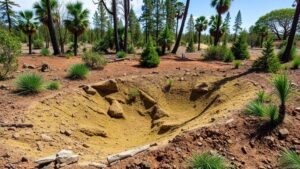Detecting in Fields With Heavy Plow Disturbance: Depth Adjustment Strategies
Detecting in Fields With Heavy Plow Disturbance: Depth Adjustment Strategies
Detecting metal objects, historical artifacts, or other valuable items in agricultural fields can pose significant challenges, particularly in areas subjected to heavy plow disturbance. Understanding how to adjust detection depth becomes crucial for both amateur enthusiasts and professional archaeologists. This article explores various strategies for effective detection in plowed fields while addressing the complexities associated with depth adjustments.
The Challenges of Heavy Plow Disturbance
Heavy plow disturbance alters the stratigraphy of the soil, making it difficult to locate objects buried beneath multiple layers of soil. processes of plowing can create a scatter effect, pushing items both deeper into the earth and closer to the surface. Plus, metal detectors must cope with a variety of soil conditions, which can be perilous for accurate readings and targeting.
- Increased Soil Volume: Disturbed soil comprises diverse layers and textures, contributing to inconsistent detection responses.
- Depth Variations: The depth at which metal objects are buried may change due to plowing techniques, leading to miscalculations.
For example, in a case study conducted in the Midwest United States, agricultural fields that were plowed several times revealed artifacts that varied in depth by as much as 10 inches due to shifting soil profiles. Such irregularities necessitate a carefully tailored approach to detection.
Depth Adjustment Strategies
To enhance detecting effectiveness in fields with heavy plow disturbance, several depth adjustment strategies can be implemented. e strategies include assessing the soil type, adjusting sensitivity levels, calibrating equipment, and employing a systematic search methodology.
1. Assessing Soil Type
A thorough analysis of the soil type is essential. Different soil conditions affect signal strength and detection depth. For example, loamy soils are easier to penetrate than rocky or clay-heavy soils. Employing soil sampling before detection can provide a clearer understanding of potential challenges.
Most modern metal detectors allow for sensitivity adjustments. Increasing sensitivity can enhance your ability to detect items at greater depths, but it can also lead to more noise from trash items. On the other hand, lowering sensitivity may reduce the chance of detecting deeper objects. Balancing these settings is critical.
- Test Runs: Conducting test runs in various soil conditions can help identify optimum sensitivity settings.
- Dynamic Adjustments: Being prepared to make real-time adjustments based on field conditions during detecting can improve results.
3. Calibrating Equipment
Calibration is vital for achieving accurate readings. Regularly calibrating metal detectors is essential, especially when transitioning between different types of soil. Calibration generally involves:
- Ground Balancing: This process minimizes false signals caused by mineralization in the soil.
- Frequency Adjustments: Selecting the right frequency impacts detection depth effectiveness; lower frequencies generally penetrate deeper.
4. Employing a Systematic Search Methodology
A structured search strategy can lead to more consistent results in fields with heavy plow activity. Consider the following methodologies:
- Grid Method: Divide the field into manageable sections and methodically search each area to ensure complete coverage.
- Layered Searching: Focus on different soil layers at various depths, allowing for a targeted approach based on potential artifact stratification.
Real-World Applications and Case Studies
Real-world applications of these strategies are visible in various archaeological and detection projects. For example, a survey conducted in North Dakota aimed at locating Civil War artifacts revealed that adjusting sensitivity levels based on soil types allowed archaeologists to recover items buried up to 14 inches deep. By employing systematic approaches, they improved their chances of locating valuable finds significantly.
Conclusion
Detecting in fields with heavy plow disturbance requires a nuanced understanding of detection depth strategies. By assessing soil types, adjusting sensitivity, calibrating equipment, and using structured search methodologies, detectorists can considerably enhance their effectiveness in uncovering artifacts and other buried treasures. As agricultural practices continue to evolve, ongoing adaptations in detection techniques will be essential for successful outcomes.
Actionable Takeaways:
- Conduct thorough soil assessments before detection.
- Experiment with sensitivity settings during fieldwork.
- Regularly calibrate your metal detection equipment.
- Adopt systematic searching methodologies for comprehensive coverage.


